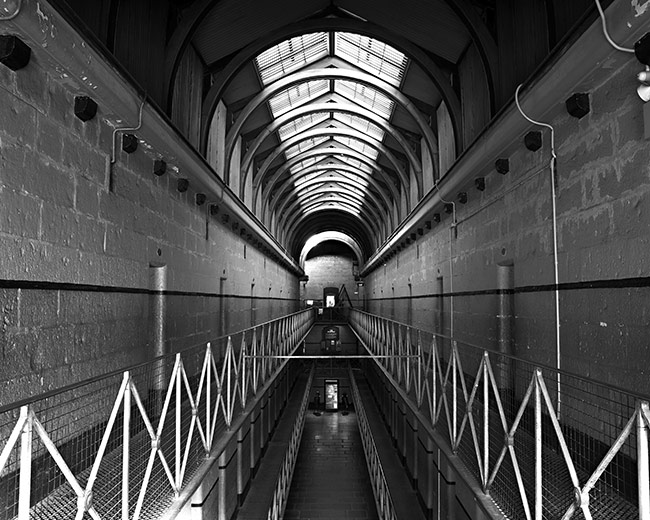This gaol is the notorious site of bushranger Ned Kelly’s hanging in 1880. It is part of a bluestone building complex that includes the Gatehouse, Courtyard and Chapel.
Less well-known historic inmates include 13 prisoners from the bloody 154 Eureka Rebellion on the Ballarat goldfields. The gaol is a popular tourist attraction and the only part of the complex not part of RMIT.
Significance
The building is classified by the National Trust of Australia (Victoria) and is designated a 'notable building' in the Melbourne City Council planning scheme. It is also on the Government Buildings Register of the Heritage Council of Victoria and the Register of the National Estate.
What to see
Three courtyards, ground floor
The courtyard behind the gates was landscaped in 1994.
The tree making its escape over the wall in the western courtyard is a Port Jackson fig.
A wall was constructed in the eastern courtyard during the 1940s to ensure the Emily McPherson College girls remained firmly separated from the cell block inmates; the wall was demolished in the late 1990s.

Bath-house, ground floor, and Chapel, leve
Directly ahead as you enter the main courtyard from Franklin Street. This wing was remodelled in 1974. The bath-house and chapel now serve as art studios.
Enclosed balcony, level B
Restored to its 1927 design by RMIT in 1990. Can you guess which is the original wall and which was built in 1990.
Building 11 (Old Melbourne Gaol)
Transport and access
Located on Russell Street, near the La Trobe Street corner, catch a City Loop train to Melbourne Central train station or to Flinders Street. From Flinders Street, you can take a connecting City Loop train or Yarra Tram along nearby Swanston Street.
Trams running along Swanston Street include routes 1, 3, 5, 6, 8, 16, 64, 67 and 72. La Trobe Street trams include routes 24, 30 and 35.
Visit the Public Transport Victoria website for more information and connecting services in your area.
No on-campus parking is available for visitors, but you’ll find many commercial car parks a short walk away. Metered street parking is also available nearby, but note the time limits and clearway restrictions.
History
"No finer record could be left by a Government than the emptying of gaols to provide accommodation for educational institutions," said the Victorian Premier, Sir Alexander Peacock, in 1914. But it was not until March 1927 that Victoria's oldest surviving penal establishment became part of the new Emily McPherson College. When the Emily Mac joined RMIT in 1979, the gaol's entrance gates and other facilities were part of the package.
The Old Melbourne Gaol was erected in stages between 1841 and 1864 by the Public Works Department, and is one of the state's most distinctive groups of bluestone buildings. Of the many criminals imprisoned, executed and buried in the gaol the most notable was Ned Kelly, who was hanged in 1880. (Kelly may have been buried elsewhere; the whereabouts of his remains are today unknown.)
The section of the gaol owned by RMIT includes the entrance block and chapel, both of which are notable for their restrained design. This section of the gaol dates back to the 1860s.
The complex is largely intact except for some sympathetic additions to the east wing of the entrance block, the first floor of the link between the chapel and entrance block, and interior renovation of the chapel.
Use of the complex as a gaol ceased in 1923. During World War 2 a rendered brick wall was constructed to separate the college from the cell block. The wall was demolished in the late 1990s.
The enclosed balcony was restored to its known 1927 design by RMIT in 1990, the inner courtyard landscaped in 1994 and the temporary war-time pavilion classrooms removed in 1995.
Construction dates
The Melbourne Gaol's main entrance gates, governor's residence, female hospital, service wing, bath-house and chapel were constructed in 1860-61. Collectively these facilities are known as RMIT Building 11. Architect: Colonial Government Architect. Remodelled for the food and fashion departments of the Emily McPherson College by architects Eggleston, McDonald and Secomb in May 1974.